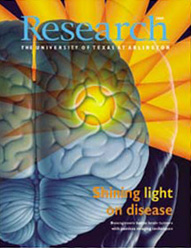A tiny protein that helps patients battle cancer. Noninvasive imaging technology that delays or prevents blindness in diabetics. New drugs that relieve chronic pain.
Sounds like groundbreaking exploration at the world’s most prestigious medical facilities. Actually, the research is taking place at UT Arlington.
 The inaugural
Research
magazine describes these and more than 20 other life-enhancing projects.
The inaugural
Research
magazine describes these and more than 20 other life-enhancing projects.
“Our faculty and students are engaged in sponsored research with world-changing potential,” said Provost Dana Dunn, co-publisher of the 32-page publication with Vice President for Research Ron Elsenbaumer. “The magazine illustrates the breadth of investigation across disciplines, including work on health care and homeland security, two of our nation’s top priorities.”
For example, professors in the Bioengineering Department are developing painless optical procedures to combat life-threatening diseases. Associate Professor Hanli Liu’s infrared optical imager shoots minuscule beams of radiation into a brain tumor focused at a single point, and Assistant Professor Karel Zuzak’s imaging system shows promise for early detection of diabetes.
In the homeland security arena, electrical engineering Associate Professor J.C. Chiao is designing low-cost, low-power, highly portable millimeter-wave sensors that can see through smoke or dust storms while also detecting toxic chemicals. Computer science and engineering Professor Sajal Das heads a team that’s combining computer technology and software with sensor systems that can either prevent or help the nation recover from natural or inflicted disasters.
Research also features federally funded projects in the burgeoning field of nanotechnology, such as nanolubricants that lead to cleaner air, nanoparticles that direct drugs to specific body parts, and nanocomposite magnets that may revolutionize the electromechanics industry.
“Recently we succeeded in producing the world’s smallest strong permanent magnets,” physics Associate Professor Ping Liu said. “These particle magnets are not available from other places and should find advanced applications.”
Articles in Research Vol. 1, No. 1 explore topics ranging from reading minds and preventing stress to life on other planets and fossil fuel alternatives. The magazine includes profiles on outstanding alumni and student researchers as well as UT Arlington’s partnerships with industry.
The publication is a much-needed tool for showcasing the University’s nationally recognized research endeavors, Dr. Elsenbaumer said. Since 2000, research expenditures at UT Arlington have increased 54 percent, and federally supported research has gone up 211 percent. In the same period, invention disclosures are up 300 percent and the number of patents filed 50 percent.
“Our growing body of researchers is in high demand. Our innovative programs are models for others to replicate. And our economic impact is firmly visible in the region,” Elsenbaumer said. “When you read Research magazine, you find out what UT Arlington is all about: thinking big and the success that follows.”
visit: www.uta.edu/researchmagazine
— Mark Permenter
| Archives
| Alumni Association |
Giving to UTA | UTA
Home Copyright © 2006 UTA Magazine. All rights reserved. |
